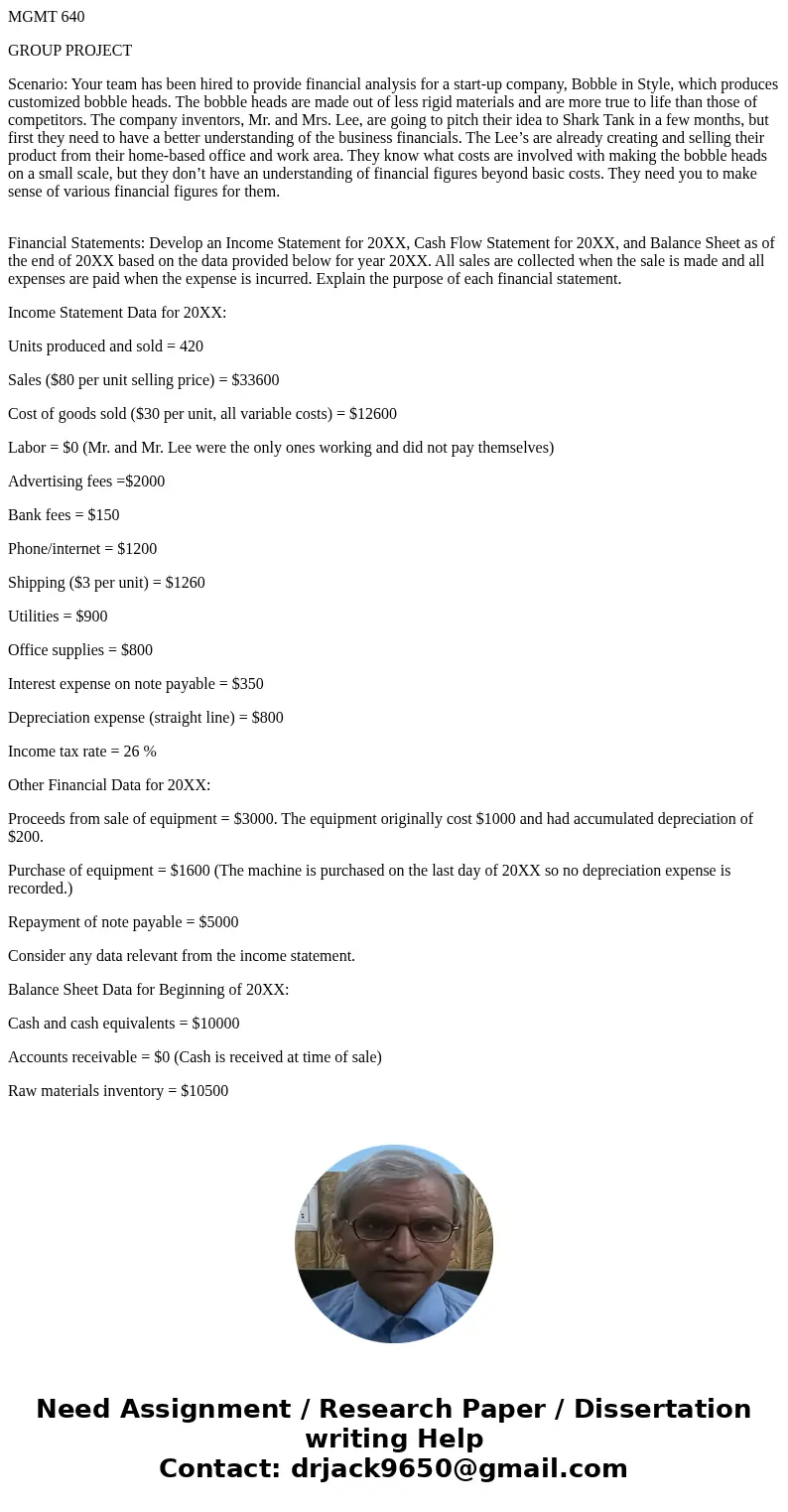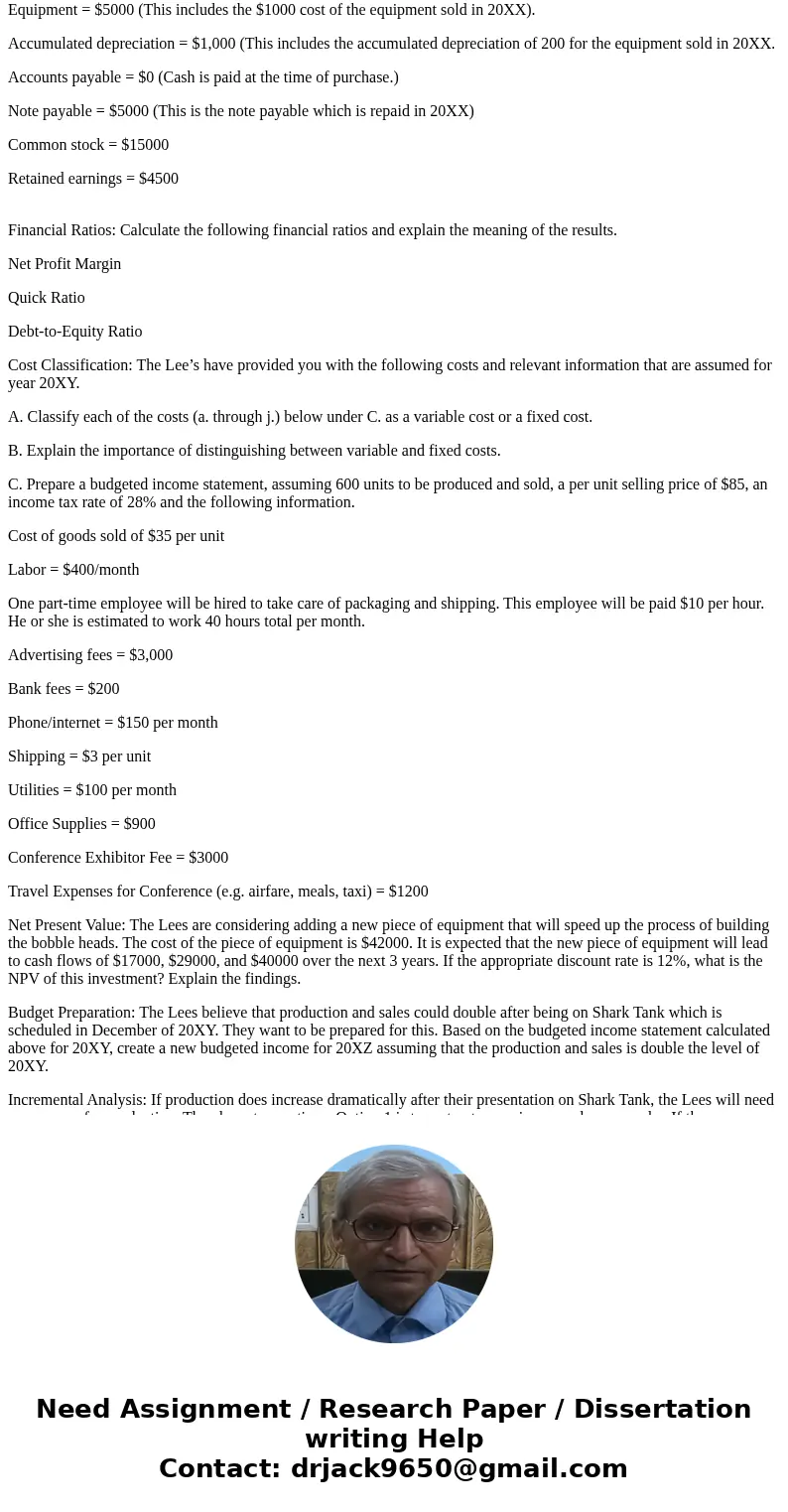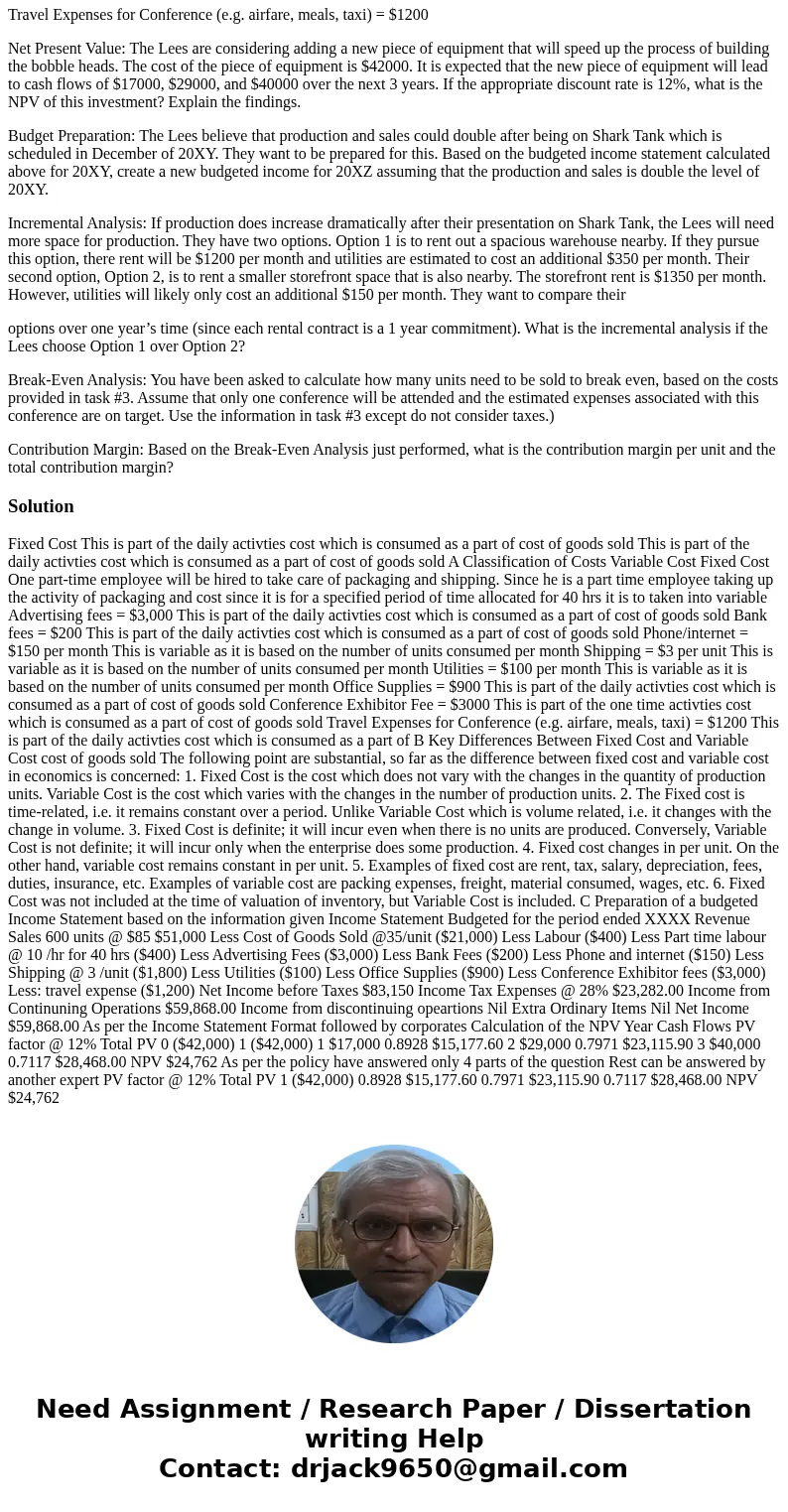MGMT 640 GROUP PROJECT Scenario Your team has been hired to
MGMT 640
GROUP PROJECT
Scenario: Your team has been hired to provide financial analysis for a start-up company, Bobble in Style, which produces customized bobble heads. The bobble heads are made out of less rigid materials and are more true to life than those of competitors. The company inventors, Mr. and Mrs. Lee, are going to pitch their idea to Shark Tank in a few months, but first they need to have a better understanding of the business financials. The Lee’s are already creating and selling their product from their home-based office and work area. They know what costs are involved with making the bobble heads on a small scale, but they don’t have an understanding of financial figures beyond basic costs. They need you to make sense of various financial figures for them.
Financial Statements: Develop an Income Statement for 20XX, Cash Flow Statement for 20XX, and Balance Sheet as of the end of 20XX based on the data provided below for year 20XX. All sales are collected when the sale is made and all expenses are paid when the expense is incurred. Explain the purpose of each financial statement.
Income Statement Data for 20XX:
Units produced and sold = 420
Sales ($80 per unit selling price) = $33600
Cost of goods sold ($30 per unit, all variable costs) = $12600
Labor = $0 (Mr. and Mr. Lee were the only ones working and did not pay themselves)
Advertising fees =$2000
Bank fees = $150
Phone/internet = $1200
Shipping ($3 per unit) = $1260
Utilities = $900
Office supplies = $800
Interest expense on note payable = $350
Depreciation expense (straight line) = $800
Income tax rate = 26 %
Other Financial Data for 20XX:
Proceeds from sale of equipment = $3000. The equipment originally cost $1000 and had accumulated depreciation of $200.
Purchase of equipment = $1600 (The machine is purchased on the last day of 20XX so no depreciation expense is recorded.)
Repayment of note payable = $5000
Consider any data relevant from the income statement.
Balance Sheet Data for Beginning of 20XX:
Cash and cash equivalents = $10000
Accounts receivable = $0 (Cash is received at time of sale)
Raw materials inventory = $10500
Equipment = $5000 (This includes the $1000 cost of the equipment sold in 20XX).
Accumulated depreciation = $1,000 (This includes the accumulated depreciation of 200 for the equipment sold in 20XX.
Accounts payable = $0 (Cash is paid at the time of purchase.)
Note payable = $5000 (This is the note payable which is repaid in 20XX)
Common stock = $15000
Retained earnings = $4500
Financial Ratios: Calculate the following financial ratios and explain the meaning of the results.
Net Profit Margin
Quick Ratio
Debt-to-Equity Ratio
Cost Classification: The Lee’s have provided you with the following costs and relevant information that are assumed for year 20XY.
A. Classify each of the costs (a. through j.) below under C. as a variable cost or a fixed cost.
B. Explain the importance of distinguishing between variable and fixed costs.
C. Prepare a budgeted income statement, assuming 600 units to be produced and sold, a per unit selling price of $85, an income tax rate of 28% and the following information.
Cost of goods sold of $35 per unit
Labor = $400/month
One part-time employee will be hired to take care of packaging and shipping. This employee will be paid $10 per hour. He or she is estimated to work 40 hours total per month.
Advertising fees = $3,000
Bank fees = $200
Phone/internet = $150 per month
Shipping = $3 per unit
Utilities = $100 per month
Office Supplies = $900
Conference Exhibitor Fee = $3000
Travel Expenses for Conference (e.g. airfare, meals, taxi) = $1200
Net Present Value: The Lees are considering adding a new piece of equipment that will speed up the process of building the bobble heads. The cost of the piece of equipment is $42000. It is expected that the new piece of equipment will lead to cash flows of $17000, $29000, and $40000 over the next 3 years. If the appropriate discount rate is 12%, what is the NPV of this investment? Explain the findings.
Budget Preparation: The Lees believe that production and sales could double after being on Shark Tank which is scheduled in December of 20XY. They want to be prepared for this. Based on the budgeted income statement calculated above for 20XY, create a new budgeted income for 20XZ assuming that the production and sales is double the level of 20XY.
Incremental Analysis: If production does increase dramatically after their presentation on Shark Tank, the Lees will need more space for production. They have two options. Option 1 is to rent out a spacious warehouse nearby. If they pursue this option, there rent will be $1200 per month and utilities are estimated to cost an additional $350 per month. Their second option, Option 2, is to rent a smaller storefront space that is also nearby. The storefront rent is $1350 per month. However, utilities will likely only cost an additional $150 per month. They want to compare their
options over one year’s time (since each rental contract is a 1 year commitment). What is the incremental analysis if the Lees choose Option 1 over Option 2?
Break-Even Analysis: You have been asked to calculate how many units need to be sold to break even, based on the costs provided in task #3. Assume that only one conference will be attended and the estimated expenses associated with this conference are on target. Use the information in task #3 except do not consider taxes.)
Contribution Margin: Based on the Break-Even Analysis just performed, what is the contribution margin per unit and the total contribution margin?
Solution
Fixed Cost This is part of the daily activties cost which is consumed as a part of cost of goods sold This is part of the daily activties cost which is consumed as a part of cost of goods sold A Classification of Costs Variable Cost Fixed Cost One part-time employee will be hired to take care of packaging and shipping. Since he is a part time employee taking up the activity of packaging and cost since it is for a specified period of time allocated for 40 hrs it is to taken into variable Advertising fees = $3,000 This is part of the daily activties cost which is consumed as a part of cost of goods sold Bank fees = $200 This is part of the daily activties cost which is consumed as a part of cost of goods sold Phone/internet = $150 per month This is variable as it is based on the number of units consumed per month Shipping = $3 per unit This is variable as it is based on the number of units consumed per month Utilities = $100 per month This is variable as it is based on the number of units consumed per month Office Supplies = $900 This is part of the daily activties cost which is consumed as a part of cost of goods sold Conference Exhibitor Fee = $3000 This is part of the one time activties cost which is consumed as a part of cost of goods sold Travel Expenses for Conference (e.g. airfare, meals, taxi) = $1200 This is part of the daily activties cost which is consumed as a part of B Key Differences Between Fixed Cost and Variable Cost cost of goods sold The following point are substantial, so far as the difference between fixed cost and variable cost in economics is concerned: 1. Fixed Cost is the cost which does not vary with the changes in the quantity of production units. Variable Cost is the cost which varies with the changes in the number of production units. 2. The Fixed cost is time-related, i.e. it remains constant over a period. Unlike Variable Cost which is volume related, i.e. it changes with the change in volume. 3. Fixed Cost is definite; it will incur even when there is no units are produced. Conversely, Variable Cost is not definite; it will incur only when the enterprise does some production. 4. Fixed cost changes in per unit. On the other hand, variable cost remains constant in per unit. 5. Examples of fixed cost are rent, tax, salary, depreciation, fees, duties, insurance, etc. Examples of variable cost are packing expenses, freight, material consumed, wages, etc. 6. Fixed Cost was not included at the time of valuation of inventory, but Variable Cost is included. C Preparation of a budgeted Income Statement based on the information given Income Statement Budgeted for the period ended XXXX Revenue Sales 600 units @ $85 $51,000 Less Cost of Goods Sold @35/unit ($21,000) Less Labour ($400) Less Part time labour @ 10 /hr for 40 hrs ($400) Less Advertising Fees ($3,000) Less Bank Fees ($200) Less Phone and internet ($150) Less Shipping @ 3 /unit ($1,800) Less Utilities ($100) Less Office Supplies ($900) Less Conference Exhibitor fees ($3,000) Less: travel expense ($1,200) Net Income before Taxes $83,150 Income Tax Expenses @ 28% $23,282.00 Income from Continuning Operations $59,868.00 Income from discontinuing opeartions Nil Extra Ordinary Items Nil Net Income $59,868.00 As per the Income Statement Format followed by corporates Calculation of the NPV Year Cash Flows PV factor @ 12% Total PV 0 ($42,000) 1 ($42,000) 1 $17,000 0.8928 $15,177.60 2 $29,000 0.7971 $23,115.90 3 $40,000 0.7117 $28,468.00 NPV $24,762 As per the policy have answered only 4 parts of the question Rest can be answered by another expert PV factor @ 12% Total PV 1 ($42,000) 0.8928 $15,177.60 0.7971 $23,115.90 0.7117 $28,468.00 NPV $24,762


 Homework Sourse
Homework Sourse